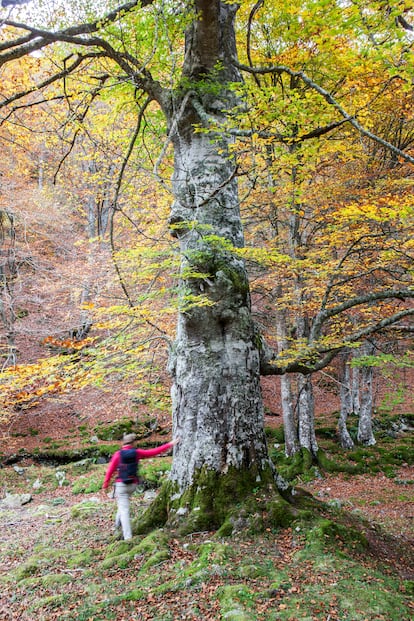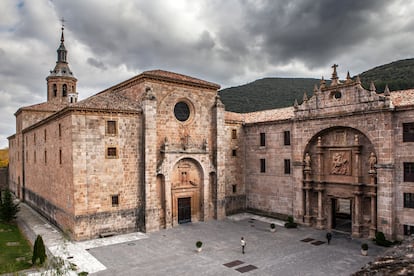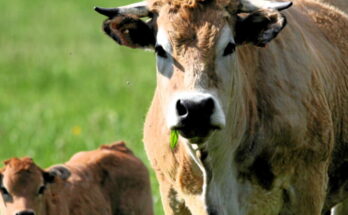“For All Saints’ sake, cold in the fields.” “For All Saints, your sown wheat.” The proverb, so observant, says nothing about the color of the woods at the beginning of November, when it is most alive. But I could say it: “For the love of All Saints, painted trees.” This is a good appointment, therefore, to get closer to the valley of the Cárdenas river, on the Rioja side of the Sierra de la Demanda, where nature now paints the beeches, oaks, mostajos and maples with the warmest colors of its palette.
It is an ideal forest for All Saints. Naturally it was for San Millán, who lived here in retirement for 40 years, at the beginning of the 6th century, long before founding the famous monastery of Suso down in the valley. The Saint’s Cave was and still is on a high cliff, with an immense view of the forest. Up there, Emiliano He spent 40 autumns seeing the most beautiful painting in the world. He was already in heaven, before he was a saint.
Short, simple and well-marked trail
Just eight kilometers from San Millán de la Cogolla, going up the LR-422 road, on the right bank of the Cárdenas river, is the Urre recreational area, where there is a car park and an information panel explaining how to go up to the Cueva del Santo. It is a well-marked path with wooden trail markers, lasting only one hour – including the return along the same path – and with a difference in altitude of 129 metres, suitable for people of all ages and physical fitness. You start by crossing the Fragosto ravine, a tributary of the Cárdenas, on a small bridge, and then climb through a dense mass of beech and hazel trees, almost like a tunnel. You soon reach the so-called Curva dei Quattro Venti, which offers a beautiful view of the valley and also a good excuse to rest, given that the slope is increasingly steeper. After this brief respite the climb continues, now zigzagging among wild pines, until reaching the rocky cut from which the Saint’s cave-house hangs like a swallow’s nest.
At the beginning of the 17th century, 1,100 years after the saint’s residence, the cave became the destination of a unique pilgrimage. A mysterious illness struck the women of San Millán de la Cogolla and the men, distressed by an illness that affected what they loved most, went up to pray for their recovery. Prayer hasn’t been bad for them, because they still continue to do it, with the men of the town who come here, themselves, every third Sunday in June.
In the same century the cave was transformed into a rock hermitage. Three walls, a roof, an altar and a door that remains open day and night have been added so that access is free. The rest remains the same. The same silence. The same loneliness. The same grandiose mountain landscape, presided over by the San Lorenzo or Cuculla peak (2,271 metres), the highest in the Demanda mountain range. And at the foot of the cave, covering the valley, the same blanket of beeches, oaks, mustaches and maples, beautiful at the beginning of November, when nature enjoys painting it brown, ocher, yellow, orange, red and purple. There are days when, to reach the San Millán cave, hikers advance on a red carpet.
Say hello to the grandparents of the forest
Since the ascent and descent to the cave are short, we can take another walk along the Cárdenas River, following the extension of the road we followed to reach the Urre recreational area by car. Without making much effort, we will discover the grandparents of the forest, two monumental trees several centuries old. One kilometer from Urre, upstream of the valley, there is the Carrias beech, an enormous specimen more than 350 years old, protected and reported as the only tree in La Rioja.

Two kilometers further on, next to the dirt road which is an extension of the asphalt road, stands the mostajo of the Cárdenas river, another three and a half century colossus. From the Urre recreation area to here it is a two-hour walk – including the return along the same path – through one of the most beautiful forests in Spain.
Yuso and Suso Monasteries
After seeing the cave and saying goodbye to the grandparents of the forest, it’s time to take the car to approach San Millán de la Cogolla and visit the monastery of Yuso or Abajo, where the saint’s remains rest. Built in the 11th century in Romanesque style and rebuilt in the 16th and 17th centuries in Herrerian style, this majestic monastery, in addition to the relics of San Millán, contains precious codices and hymn books (some weighing 60 kilos). You can also admire a copy of the Emilian glosses, notes that a monk wrote about a thousand years ago in the margin of a Latin text and that they are considered the “first vagido of the Spanish language,” as Dámaso Alonso said.

Yuso is one of the largest and most impressive monasteries in Spain, The Escorial of Rioja. That of Suso or Arriba, however, hidden among the mountains less than a kilometer away, is a small, simple, rustic and fascinating monastery, where the aroma of the High Middle Ages is preserved, when men like San Millán, the purest spirits of Visigothic Hispania, retreated to the most remote places to lead an austere and solitary life, in imitation of what the Desert Fathers had done in Syria and Egypt in the 4th century. The Sacred Grotto was his first retreat, his desert of youth. Suso was the definitive one, where he lived until the age of one hundred.
Unfortunately, the Suso Monastery has been closed for consolidation and restoration works since January 2025 and the works are taking a long time. Since it cannot be visited and access by car is prohibited (except for authorized vehicles), the only way to go up and take a look is to walk across the mountain. There is a marked Yuso-Suso pedestrian route, very simple, only 2.6 kilometers long. And there is a longer – 7.7 kilometers – and interesting circular route, which connects the two monasteries, both declared a UNESCO world heritage site in 1997, and the town of Berceo, where the saint was born in 472 and in 1196 by Gonzalo de Berceo, considered the first poet in the Spanish language, who wrote: like another Latin, moreover, San Millán spent three years as a priest after his first retirement, but was so generous to the poor that other clerics accused him of squandering ecclesiastical goods and he ended up hanging up his cassock and retreating to the mountains, far from the mad crowd.




